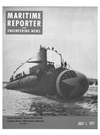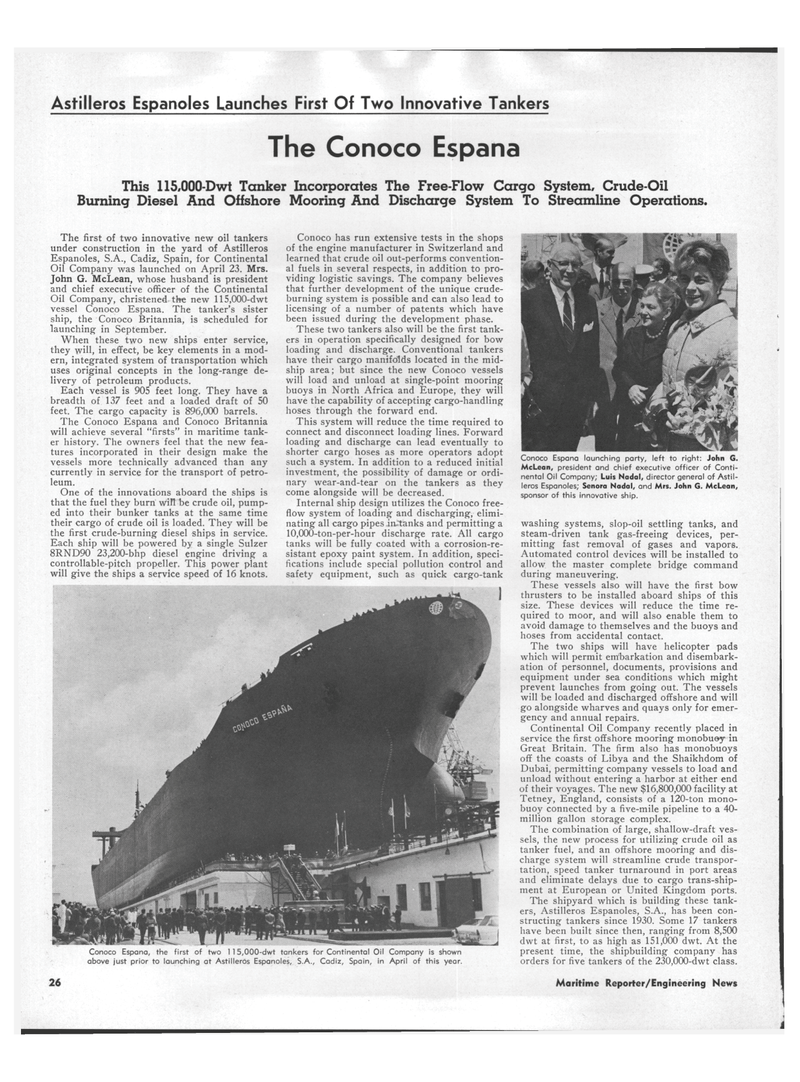
Page 20: of Maritime Reporter Magazine (July 1971)
Read this page in Pdf, Flash or Html5 edition of July 1971 Maritime Reporter Magazine
Astilleros Espanoles Launches First Of Two Innovative Tankers
The Conoco Espana
This 115,000-Dwt Tanker Incorporates The Free-Flow Cargo System, Crude-Oil
Burning Diesel And Offshore Mooring And Discharge System To Streamline Operations.
Conoco Espana launching party, left to right: John G.
McLean, president and chief executive officer of Conti- nental Oil Company; Luis Nadal, director general of Astil- leros Espanoles; Senora Nadal, and Mrs. John G. McLean, sponsor of this innovative ship. washing systems, slop-oil settling tanks, and steam-driven tank gas-freeing devices, per- mitting fast removal of gases and vapors.
Automated control devices will be installed to allow the master complete bridge command during maneuvering.
These vessels also will have the first bow thrusters to be installed aboard ships of this size. These devices will reduce the time re- quired to moor, and will also enable them to avoid damage to themselves and the buoys and hoses from accidental contact.
The two ships will have helicopter pads which will permit em'barkation and disembark- ation of personnel, documents, provisions and equipment under sea conditions which might prevent launches from going out. The vessels will be loaded and discharged offshore and will go alongside wharves and quays only for emer- gency and annual repairs.
Continental Oil Company recently placed in service the first offshore mooring monobuoy in
Great Britain. The firm also has monobuoys off the coasts of Libya and the Shaikhdom of
Dubai, permitting company vessels to load and unload without entering a harbor at either end of their voyages. The new $16,800,000 facility at
Tetney, England, consists of a 120-ton mono- buoy connected by a five-mile pipeline to a 40- million gallon storage complex.
The combination of large, shallow-draft ves- sels, the new process for utilizing crude oil as tanker fuel, and an offshore mooring and dis- charge system will streamline crude transpor- tation, speed tanker turnaround in port areas and eliminate delays due to cargo trans-ship- ment at European or United Kingdom ports.
The shipyard which is building these tank- ers, Astilleros Espanoles, S.A., has been con- structing tankers since 1930. Some 17 tankers have been built since then, ranging from 8,500 dwt at first, to as high as 151,000 dwt. At the present time, the shipbuilding company has orders for five tankers of the 230,000-dwt class. 22 Maritime Reporter/Engineering News
Conoco Espana, the first of two 1 15,000-dwt tankers for Continental Oil Company is shown above just prior to launching at Astilleros Espanoles, S.A., Cadiz, Spain, in April of this year.
The first of two innovative new oil tankers under construction in the yard of Astilleros
Espanoles, S.A., Cadiz, Spain, for Continental
Oil Company was launched on April 23. Mrs.
John G. McLean, whose husband is president and chief executive officer of the Continental
Oil Company, christened the new 115,000-dwt vessel Conoco Espana. The tanker's sister ship, the Conoco Britannia, is scheduled for launching in September.
When these two new ships enter service, they will, in effect, be key elements in a mod- ern, integrated system of transportation which uses original concepts in the long-range de- livery of petroleum products.
Each vessel is 905 feet long. They have a breadth of 137 feet and a loaded draft of 50 feet. The cargo capacity is 896,000 barrels.
The Conoco Espana and Conoco Britannia will achieve several "firsts" in maritime tank- er history. The owners feel that the new fea- tures incorporated in their design make the vessels more technically advanced than any currently in service for the transport of petro- leum.
One of the innovations aboard the ships is that the fuel they burn will be crude oil, pump- ed into their bunker tanks at the same time their cargo of crude oil is loaded. They will be the first crude-burning diesel ships in service.
Each ship will be powered by a single Sulzer 8RND90 23,200-bhp diesel engine driving a controllable-pitch propeller. This power plant will give the ships a service speed of 16 knots.
Conoco has run extensive tests in the shops of the engine manufacturer in Switzerland and learned that crude oil out-performs convention- al fuels in several respects, in addition to pro- viding logistic savings. The company believes that further development of the unique crude- burning system is possible and can also lead to licensing of a number of patents which have been issued during the development phase.
These two tankers also will be the first tank- ers in operation specifically designed for bow loading and discharge. Conventional tankers have their cargo manifolds located in the mid- ship area; but since the new Conoco vessels will load and unload at single-point mooring buoys in North Africa and Europe, they will have the capability of accepting cargo-handling hoses through the forward end.
This system will reduce the time required to connect and disconnect loading lines. Forward loading and discharge can lead eventually to shorter cargo hoses as more operators adopt such a system. In addition to a reduced initial investment, the possibility of damage or ordi- nary wear-and-tear on the tankers as they come alongside will be decreased.
Internal ship design utilizes the Conoco free- flow system of loading and discharging, elimi- nating all cargo pipes in^tanks and permitting a 10,000-ton-per-hour discharge rate. All cargo tanks will be fully coated with a corrosion-re- sistant epoxy paint system. In addition, speci- fications include special pollution control and safety equipment, such as quick cargo-tank

 19
19

 21
21
